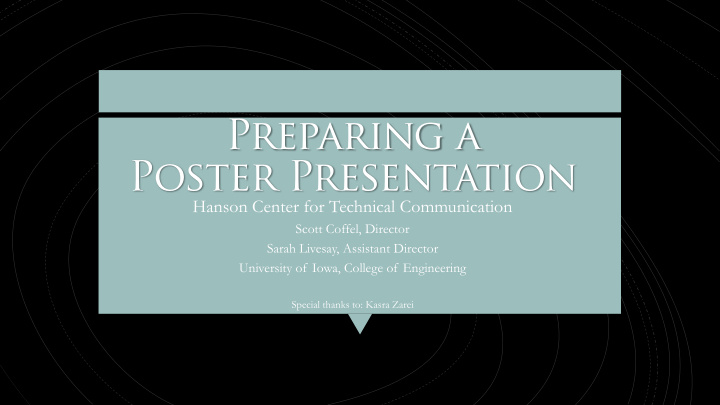



Preparing a Poster Presentation Hanson Center for Technical Communication Scott Coffel, Director Sarah Livesay, Assistant Director University of Iowa, College of Engineering Special thanks to: Kasra Zarei
Workshop description: “In addition to helping you visually represent your research project, this workshop provides a wealth of Overview advice for communicating with clarity and insight.” of Workshop: In other words, this presentation will: Provide direction on the visual layout on the poster. Provide guidance for the oral communication of the poster.
How many of you: participate in undergraduate research? Audience are presenting at an upcoming poster session? Poll have presented your work before?
Poster presentations give the speaker the opportunity to: Organize knowledge for the benefit of others. Benefits of Motivate audiences to ask questions. Presentations Build credibility as a subject matter expert.
A large-format poster is a piece of paper (or monitor) that: Communicates your research. Introduces your question. Purpose of Provides an overview of your novel approach. Summarizes your results in a graph, table, figure, or other visual means. Poster Includes discussion of results. Presentation Lists previously published articles that are important to your research. Acknowledges assistance and financial support from others. If text is kept to a minimum, a person could read your entire poster in under 5 minutes. Source: Purrington, C. (2017). Designing Conference Posters [Blog post]. Retrieved from https://colinpurrington.com/tips/poster-design.
1. Miscellany: title bar, authorship, affiliations, logos, acknowledgements 2. Abstract (not always required) Included 3. Introduction/Background on Poster 4. Methods/Materials 5. Results 6. Conclusions/Discussion 7. References
Retrieved from: file:///D:/Documents/Administrative/PPTs/scientific-poster-advice-purrington.pdf.
Limit the amount of words on your poster (but save them for a journal article). Revise several times. Tips for Preparing a Ensure that it is readable from a few yards away. Poster Do not use first person. Tell a story about your research.
Poster Talk The Spoken Presentation
Introduce your subject with an attention-getting question, statistic, or image. Oral Presentation Tell your audience what they can expect to learn. guidelines Clarify/support what they should remember. Conclude with a strong take-away message.
Listening requires work. Too much or disorganized information hinders their comprehension. The Listeners think faster than you can speak, so their minds struggle wander while they listen. with Audiences Strategies: Before introducing new material, stop to remind your audience what they have learned so far. Highlight important terms and repeat them often .
Speaking to colleagues and experts gives you more freedom to use specialized terms without providing definitions or context. Speaking to a more general audience allows you to Understanding convince those outside your field of the importance of Your Audience your project. The ability to shift gears for different audiences (sometimes all listening at the same time) is a quality of a successful communicator.
Practice Delivery Practice Practice
Practice your speech with someone who is familiar with your work (such as a co-worker or mentor) and someone who is not familiar with your work (such as a non-engineering roommate). Know your audience. You do not need to dumb down your work. Rather, tailor your work to your audience so that you present an overview of the project without eliminating technicalities. Practice Develop a hook that will lead right from your introduction Presenting into your background. Describe your methods in the order you performed them. Verbally tie your results back to your background section. Your audience will appreciate the oral call back to your introductory material. Feel free to postulate about the future direction of your work.
Does the introduction: 1. Prompt interest in the project? Delivering 2. Your Forecast your objectives (what your listeners can expect to learn)? Introduction 3. Adopt a tone appropriate to the audience?
Does the body of your talk: 1. Give your audience a map and help them understand the Delivering relationship of one topic with another? your 2. Define key terms and concepts? Presentation 3. Visualize your subject from multiple perspectives? 4. Employ analogies to help audiences grasp unfamiliar materials? a) Example: Watson and Crick described the structure of DNA as a zipper.
http://academics.umw.edu/speaking/speaking-center/useful- handouts/ Resources https://speakingcenter.uiowa.edu/resources https://speakingcenter.uncg.edu/resources/tip-sheets/
Questions?
Poster Text The Written Presentation
Write a list of keywords and key points that have been demonstrated by the study. Preserve the technicalities of your work, but do not over- explain. Crafting Draft a few titles and have a co-worker or a mentor review your Title them before deciding on a final version. Save writing the title until the end of the poster-drafting process.
Start with the problem that your study addresses. Describe the current research in this area. Mention any established models that you are using, Narrow in on your specific research question, hypothesis, Introduction and the purpose of your study. Describe previous research studies, shortcomings in your research question, and other possible results of a literature search.
Describe the techniques used. Include information about sample sizes used for data analysis. Utilize a Data Flow Diagram. Methods Be as concise as possible while still including all elements necessary to allow interpretation and replication of the results.
Present your results as figures and additional statistics. Results Do not interpret your results, because any discussion should be saved for the conclusions section.
Keep your discussion focused on what you demonstrated in your study. Re-iterate the major statistics from your data analysis. Conclusions
Recommend
More recommend